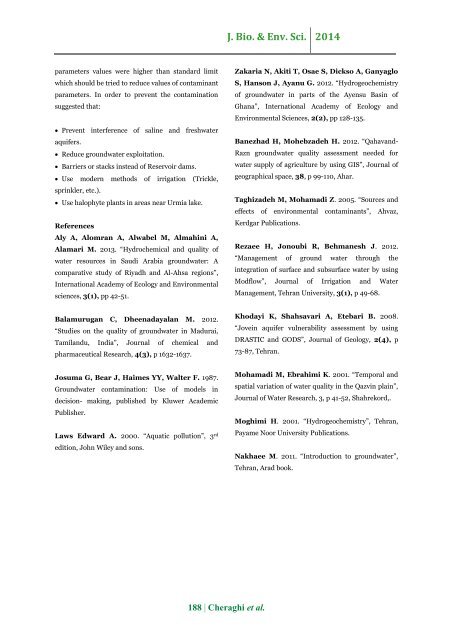Evaluating groundwater contamination of Urmia plain by using GIS
Abstract The purpose of this study is to update the information and determining the chemical quality of ground water in Urmia plain in order to control the contamination and optimal utilization of these resources. In this research, to evaluate chemical parameters of water quality (Sodium, hardness, bicarbonate, calcium, sulfate, chloride, electrical conductivity and pH and total soluble salts) 70 wells were selected. Then maximum, minimum, average, standard deviation and coefficient of variation were determined by using GIS package and Excel software. The average of each parameter was analyzed during 2001-2011 and compared with international standards. The results demonstrate that average of sodium and electrical conductivity in drinking water is close to Europe standards and average of pH and chloride is less than mentioned standards. Based on the chemical composition of water and zoning maps, it seems that agricultural activities (excessive use of chemical fertilizers, pesticides and agricultural waste) and Urmia saline lake were effective in contaminating eastern parts of the plain.
Abstract
The purpose of this study is to update the information and determining the chemical quality of ground water in Urmia plain in order to control the contamination and optimal utilization of these resources. In this research, to evaluate chemical parameters of water quality (Sodium, hardness, bicarbonate, calcium, sulfate, chloride, electrical conductivity and pH and total soluble salts) 70 wells were selected. Then maximum, minimum, average, standard deviation and coefficient of variation were determined by using GIS package and Excel software. The average of each parameter was analyzed during 2001-2011 and compared with international standards. The results demonstrate that average of sodium and electrical conductivity in drinking water is close to Europe standards and average of pH and chloride is less than mentioned standards. Based on the chemical composition of water and zoning maps, it seems that agricultural activities (excessive use of chemical fertilizers, pesticides and agricultural waste) and Urmia saline lake were effective in contaminating eastern parts of the plain.
You also want an ePaper? Increase the reach of your titles
YUMPU automatically turns print PDFs into web optimized ePapers that Google loves.
J. Bio. & Env. Sci. 2014<br />
parameters values were higher than standard limit<br />
which should be tried to reduce values <strong>of</strong> contaminant<br />
parameters. In order to prevent the <strong>contamination</strong><br />
suggested that:<br />
Prevent interference <strong>of</strong> saline and freshwater<br />
aquifers.<br />
Reduce <strong>groundwater</strong> exploitation.<br />
Barriers or stacks instead <strong>of</strong> Reservoir dams.<br />
Use modern methods <strong>of</strong> irrigation (Trickle,<br />
sprinkler, etc.).<br />
Use halophyte plants in areas near <strong>Urmia</strong> lake.<br />
References<br />
Aly A, Alomran A, Alwabel M, Almahini A,<br />
Alamari M. 2013. “Hydrochemical and quality <strong>of</strong><br />
water resources in Saudi Arabia <strong>groundwater</strong>: A<br />
comparative study <strong>of</strong> Riyadh and Al-Ahsa regions”,<br />
International Academy <strong>of</strong> Ecology and Environmental<br />
sciences, 3(1), pp 42-51.<br />
Zakaria N, Akiti T, Osae S, Dickso A, Ganyaglo<br />
S, Hanson J, Ayanu G. 2012. “Hydrogeochemistry<br />
<strong>of</strong> <strong>groundwater</strong> in parts <strong>of</strong> the Ayensu Basin <strong>of</strong><br />
Ghana”, International Academy <strong>of</strong> Ecology and<br />
Environmental Sciences, 2(2), pp 128-135.<br />
Banezhad H, Mohebzadeh H. 2012. “Qahavand-<br />
Razn <strong>groundwater</strong> quality assessment needed for<br />
water supply <strong>of</strong> agriculture <strong>by</strong> <strong>using</strong> <strong>GIS</strong>”, Journal <strong>of</strong><br />
geographical space, 38, p 99-110, Ahar.<br />
Taghizadeh M, Mohamadi Z. 2005. “Sources and<br />
effects <strong>of</strong> environmental contaminants”, Ahvaz,<br />
Kerdgar Publications.<br />
Rezaee H, Jonoubi R, Behmanesh J. 2012.<br />
“Management <strong>of</strong> ground water through the<br />
integration <strong>of</strong> surface and subsurface water <strong>by</strong> <strong>using</strong><br />
Modflow”, Journal <strong>of</strong> Irrigation and Water<br />
Management, Tehran University, 3(1), p 49-68.<br />
Balamurugan C, Dheenadayalan M. 2012.<br />
“Studies on the quality <strong>of</strong> <strong>groundwater</strong> in Madurai,<br />
Tamilandu, India”, Journal <strong>of</strong> chemical and<br />
pharmaceutical Research, 4(3), p 1632-1637.<br />
Khodayi K, Shahsavari A, Etebari B. 2008.<br />
“Jovein aquifer vulnerability assessment <strong>by</strong> <strong>using</strong><br />
DRASTIC and GODS”, Journal <strong>of</strong> Geology, 2(4), p<br />
73-87, Tehran.<br />
Josuma G, Bear J, Haimes YY, Walter F. 1987.<br />
Groundwater <strong>contamination</strong>: Use <strong>of</strong> models in<br />
decision- making, published <strong>by</strong> Kluwer Academic<br />
Publisher.<br />
Laws Edward A. 2000. “Aquatic pollution”, 3 rd<br />
edition, John Wiley and sons.<br />
Mohamadi M, Ebrahimi K. 2001. “Temporal and<br />
spatial variation <strong>of</strong> water quality in the Qazvin <strong>plain</strong>”,<br />
Journal <strong>of</strong> Water Research, 3, p 41-52, Shahrekord,.<br />
Moghimi H. 2001. “Hydrogeochemistry”, Tehran,<br />
Payame Noor University Publications.<br />
Nakhaee M. 2011. “Introduction to <strong>groundwater</strong>”,<br />
Tehran, Arad book.<br />
188 | Cheraghi et al.





![Review on: impact of seed rates and method of sowing on yield and yield related traits of Teff [Eragrostis teff (Zucc.) Trotter] | IJAAR @yumpu](https://documents.yumpu.com/000/066/025/853/c0a2f1eefa2ed71422e741fbc2b37a5fd6200cb1/6b7767675149533469736965546e4c6a4e57325054773d3d/4f6e6531383245617a537a49397878747846574858513d3d.jpg?AWSAccessKeyId=AKIAICNEWSPSEKTJ5M3Q&Expires=1714784400&Signature=qGjxEnXdYYykFOicVMHgdyApeVY%3D)












